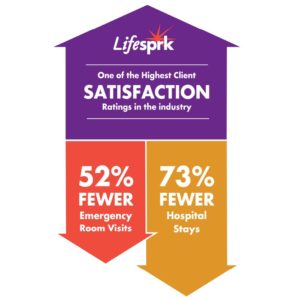
Despite political change in Washington, the drive toward reforming care continues. Health systems are making major strides toward stratifying their populations to better understand the efficacy of treatments and interventions into high risk/high cost patients to meet the demands of a changing reimbursement system. However, the time is now for new partnership models that break down existing silos to create systems of excellence that extend far into the communities where people live.
A recent article in Hospital & Health Networks captured this eloquently stating “health care is a field that’s ripe for disruption, and as such, hospitals are susceptible to falling into the potential ‘legacy traps’ that cut down former giants like Blockbuster, Borders and Circuit City. One Michigan health system, however, has an idea of how to avoid that trap, and get customers coming to the hospital, even when they’re not sick.” The answer: create an ecosystem of health that meets people where they are, becomes a part of their daily life, extends support beyond the visit, and uses partnerships.
Most current efforts though don’t go far enough, missing opportunities to truly create a population health model that improves outcomes, lowers costs, and builds life-long affinity with people where they live, play, and work. It is work that strives for the Triple Aim and the HIIN Partnership for Patients Initiative but then takes it to an entirely new level.
As the whole person population health model for seniors, Lifespark has become the largest provider of life care in the Twin Cities and a catalyst for change across the country with a mission to spark lives. We work with a wide range of partners to deliver a successful, executable population health platform that drives revenue as well as improved outcomes and overall quality of life to reduce ER visits by 52% and hospitalizations by 73%. While our work continues to evolve and develop, we see the opportunity for a few forward-thinking health organizations to disrupt Minnesota market with a stronger community-based population health platform.
So where are those opportunities to reach further into the community to achieve Triple Aim through population health?
Shift from ‘sick care’ to ‘wellness’: As long as our focus remains on care f
 or people who are sick, we will not be relevant to clients and families, no matter how loyal they are to our system, once they are well again. We will be destined to remain resources they turn to only after a health issue has arisen with little ability to impact their overall ongoing wellbeing.
or people who are sick, we will not be relevant to clients and families, no matter how loyal they are to our system, once they are well again. We will be destined to remain resources they turn to only after a health issue has arisen with little ability to impact their overall ongoing wellbeing.
Extend care management long-term into the community: We know that care management works, and every provider and payer has some iteration of care management. Yet most care management ends after 30, 60, or 90 days, or is limited in scope. That leaves a gap where little problems can arise and fester unaddressed, until they become a full-blown health crisis. This void is a huge opportunity to transform healthcare from reactive to proactive at a critical time in history to have a positive and profound effect on millions of lives. This long-term ongoing connection also affords the opportunity for life-long affinity and partnership with people, creating customers-for-life.
For example, using a whole person, long-term approach Lifespark has partnered with Augustana Care to create the Thrive On Transitions program that has already produced reductions of up to 65% in readmissions for medium and high-risk members, but the true measure will be in the months and years ahead as the long-term care management model continues to build stronger relationships with members to influence their wellbeing.
Broaden the narrow medical focus to a whole person focus: A broader whole person approach addresses myriad issues such as social isolation, housing, behavioral health, and even living with purpose that are increasingly demonstrated to impact outcomes and drive costs yet rarely addressed by current methodologies and treatments. We know the algorithm for AMI but what is the algorithm for loneliness or living with purpose?
Give more than lip service to person-centric care: It is all the buzz in health care now to talk about person-centered care, yet it is far more difficult to deliver it – to truly deliver it. Do we ask what our clients and their families want? And then do we create a pathway to that? What if what they want is different than the medical goal? How we manage the tensions that arise with these questions points to how true our person-centric approach is. Beyond ‘health,’ we need to take an approach that discovers all areas of a person’s life, including their purpose and passion, and most importantly, sparks their lives.
Create a ‘senior population health ecosystem’: No single provider can deliver population health alone, especially for seniors. The challenge is broader than the potential scope of any one organization, no matter how diverse. When you shift your thinking from sick care to wellness, it introduces a host of new services (and opportunities) that can’t be delivered solely through an expanded network of clinics, physicians, and health-related programs. It demands collaboration among like-minded partners who share protocols, outcome/goal alignment, communication, and coordination while providing complementary services that can range from housing and home repair to exercise, dining, transportation, and home health.
Transform ‘Big Data’ into the ‘right data’: EMRs have enabled tremendous data capture but issues of interoperability and data-overload keep providers from harnessing the full power of data to inform decisions and move into the realm of predictive analytics. What’s more, the scope of data collection may too narrowly focus on medical factors without incorporating other life factors that significantly impact outcomes. For example, current risk stratification tools may not go far enough and need to be married with other well-documented tools such as PROMIS to create a more accurate picture of risk, and the factors that affect risk over time. We need to be bold enough to look beyond the medical record that exists as record of care, and create a life record that reflects a plan for health.
Working as a catalyst for change, Lifespark is adhering to Atul Gawande’s call for more ‘testing, testing’ by creating pilots and phased-integrations to help partners further expand their population health models into the community, advance our learning, and seize these opportunities to achieve the Triple Aim and go beyond.
Written by Matt Kinne, Vice President, Population Health for Lifespark, this article was also published in the November 2016 Minnesota Hospital Association Healthcare Leader newsletter. Matt brings more than 15 years’ experience in the health and senior care industries, with a background in hospital/health system, rehabilitation, skilled nursing facilities, and senior housing.



